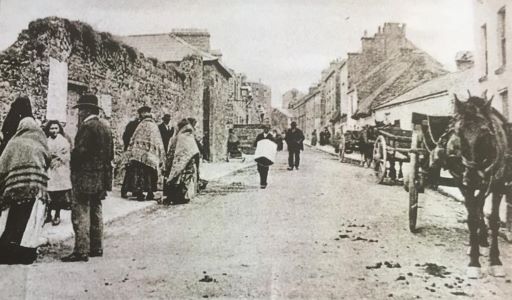EYRE STREET AT THE TURN OF THE CENTURY

by Tom Kenny
Edward Eyre arrived in Galway with the Cromwellian army, became a major political figure and secured extensive grants from the Corporation and a considerable amount of property in both the city and county, mostly from displaced Catholic families, in the period 1660 – 1670. Most of this property was outside the town walls and included areas that we now know as the Railway station, Forthill Cemetery, Victoria Place, Merchant’s Road, the Commercial Dock, Woodquay, Suckeen and Eyre Square.
Another Eyre property was what we now call Eyre Street which connects Woodquay and the Square. It was not always known by that name; on a 1712 map it is described as “The road leading from the bridge to Bohermore”, but from the early nineteenth century it began to appear on maps as Eyre Street.
Our image looking up the street, dates from c.1890 and shows, on the left, a number of people who were probably attending the potato market in Woodquay. The horses and carts parked on the right probably carried some of the farmers trying to sell their produce in that market. You can see from the horse manure on the street that this was the main form of transport, apart from Shank’s mare, for people coming in to the city. This was a very good reason for P.J. Irwin, the undertaker from Abbeygate Street, to take over Mack’s Royal Livery Yard on Eyre Street c.1900. In addition to providing a stable for his own horse-drawn hearse, he was able to provide ‘every attention and convenience for horses, cars and carriages’ for visitors.
Eyre Street (Sráid an Iarsaigh) was also home to a number of small hotels … The Connaught Family and Commercial Hotel which is most centrally situated in one of the most healthy locations in Galway … whose premises are supplied with the most modern sanitary arrangements’ according to the proprietor, George Stanton; The Corrib Hotel, Mrs. Crowe, proprietress; Baker’s Hotel which later became The Ivy which was run by Julia Poniard. Some years later O’Neill’s Hotel became a feature on the street.
The derelict building on the left was at the corner of Woodquay and was later developed to become Creavin’s Boot Shop. Among those further up on the left were O’Reillys, Brodericks, Tommy Hanley’s pub, Sheila Garvey’s vegetable and sweet shop, Baker’s Billiard Rooms.
The building we see on the far right was Fahy’s Flour Shop, then Cloherty’s house which was later occupied by Molloy’s. Next door lived an old retired soldier named Cullen, then Fitzgerald’s thatched pub, Paddy Lydon’s pub and further on lived a ropemaker.
.png)